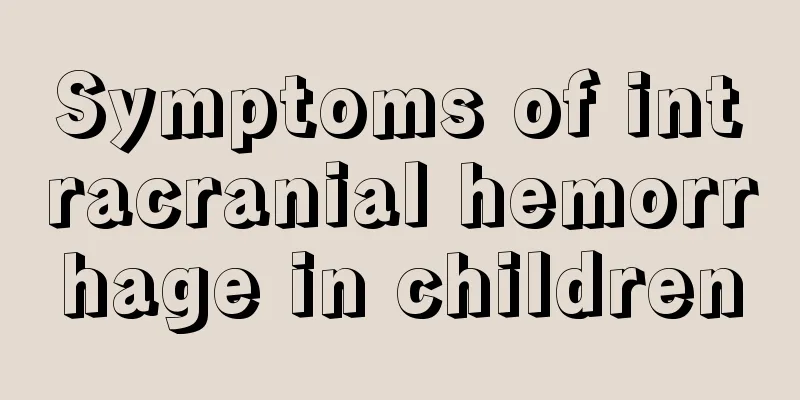Symptoms of intracranial hemorrhage in children

|
Many newborns will suffer from intracranial hemorrhage as soon as they are born. The child will suffer from severe hypoxia around the intracranial hemorrhage, which threatens the child's life and puts the child in danger. Some children are prone to intracranial hemorrhage after trauma. There are also many premature babies who are prone to intracranial hemorrhage in the state of severe cerebral vascular malformation. So what are the symptoms when a child has intracranial phenomenon? 1. Brain hemorrhage Refers to bleeding caused by rupture of blood vessels in the brain parenchyma. It is common in the cerebral hemispheres, and infratentorial hemorrhage (cerebellum or brainstem) is less common. There may be triggers such as trauma, excessive excitement, etc. before the onset of the disease. The onset is relatively acute, and common symptoms include sudden headache, vomiting, hemiplegia, aphasia, convulsions, blurred vision or hemianopsia, sensory impairment, changes in blood pressure, heart rate, breathing, and impaired consciousness. Severely ill children generally have obvious changes in vital signs, and are prone to gastrointestinal bleeding, abnormal cardiopulmonary function, and water and electrolyte imbalances. Especially severe cases may be accompanied by brain herniation and death. If the hematoma ruptures into the subarachnoid space, there are often obvious signs of meningeal irritation. Intraventricular hemorrhage is often manifested by deep coma, flaccid paralysis of the limbs, high fever in the early stage, bilateral pupil constriction, and decerebrate tonic seizures. 2. Primary subarachnoid hemorrhage Primary subarachnoid hemorrhage refers to the rupture of blood vessels at the skull base or brain surface due to non-traumatic reasons, with a large amount of blood flowing directly into the subarachnoid space; while secondary subarachnoid hemorrhage is caused by blood flow penetrating through brain tissue and spreading to the ventricles and subarachnoid space after cerebral hemorrhage. Those caused by vascular abnormalities such as aneurysms and arteriovenous malformations are more common in children over 6 years old, and the incidence tends to increase gradually with age. The onset is often acute, with the main manifestations being meningeal irritation signs and intracranial hypertension signs caused by blood stimulation or increased blood volume, such as neck stiffness, severe headache, projectile vomiting, etc. More than half of the cases experienced impaired consciousness, pale complexion and convulsions. Fever often occurs within the first 2 to 3 days of the disease. Subarachnoid hemorrhage caused by rupture of blood vessels on the convex surface of the brain may often cause obvious mental symptoms if the lesion is close to the frontal lobe and temporal lobe, which may manifest as nonsensical speech, talking to oneself, imitating language, and touching the air. It may be accompanied by hematoma or cerebral infarction and cause focal neurological signs such as limb paralysis and cranial nerve abnormalities. Fundus examination revealed subvitreal hemorrhage. 3. Subdural hemorrhage It is more common in infants and young children. It is usually divided into two types: supratentorial and infratentorial. The former is the most common, mostly caused by tearing and bleeding of small bridging veins on the surface of the brain; the latter is mostly caused by tearing of the tentorial cerebellum. Hematomas caused by subdural hemorrhage mostly occur at the top of the brain and are mostly bilateral. Subdural hemorrhage located on the convex surface of the cerebral hemisphere may not cause obvious symptoms if the amount of bleeding is small; if the amount of bleeding is large, focal signs such as increased intracranial pressure, impaired consciousness, convulsions or hemiplegia, strabismus, etc. may occur, and even secondary brain herniation leading to death. Infratentorial subdural hematoma usually causes heavy bleeding, and often quickly leads to symptoms of brainstem compression such as coma, impaired eye movement, anisocoria and loss of light reflex, and irregular breathing. The disease progresses extremely rapidly, and often respiratory arrest and death occur within a few hours. 4. NICH It mainly includes four types: periventricular and intraventricular hemorrhage, subdural hemorrhage, primary subarachnoid hemorrhage and intracerebral parenchymal hemorrhage. Bleeding may also occur in the cerebellum, thalamus, basal ganglia and other parts. Periventricular-intraventricular hemorrhage mainly occurs in immature infants of young gestational age. It is caused by the rupture of capillaries in the germinal layer under the ependyma. It usually occurs within 24 to 48 hours after birth. Most of them have an acute onset and progressive deterioration. Deep coma, decerebrate rigidity and convulsions occur soon after birth, and most of them die within a few hours. However, in a few cases, the initial symptoms may be atypical, and there may be impaired consciousness, localized "micro" convulsions, oculomotor disorders, limb dysfunction, etc. The symptoms fluctuate, sometimes mild and sometimes severe. Most of them survive, but are prone to complications of hydrocephalus. The clinical manifestations of neonatal subdural hemorrhage are similar to those discussed above. The clinical manifestations of primary subarachnoid hemorrhage are related to the amount of bleeding. When the bleeding is mild, there may be no symptoms or signs, only bloody cerebrospinal fluid. When the bleeding is heavy, drowsiness and convulsions often occur 2 to 3 days after birth, which may lead to post-hemorrhagic hydrocephalus. Massive bleeding is rare, the condition is serious, and death occurs shortly after birth. The degree of intraparenchymal hemorrhage varies greatly, and can be roughly divided into punctate hemorrhage, multifocal intraparenchymal hemorrhage in premature infants, and intraparenchymal hemorrhage caused by cerebral vascular malformations: simple punctate hemorrhage has no obvious clinical neurological symptoms and generally does not leave serious neurological problems; multifocal intraparenchymal hemorrhage in premature infants often occurs in premature infants with very small gestational age and birth weight, with obvious clinical neurological abnormalities and a poor prognosis, with the outcome being multifocal brain tissue liquefaction; intraparenchymal hemorrhage caused by cerebral vascular malformations is mostly sudden, and the prognosis is related to the site and size of the bleeding focus, the degree of compression and edema of the surrounding tissues, and the treatment status. Cerebellar hemorrhage can cause quadriplegia, shallow breathing, repeated suffocation attacks, etc. due to compression of the brain stem, and may lead to death within a short period of time. Please be careful. Children must receive timely treatment after suffering intracranial hemorrhage. There are many methods of treatment, which can be decided according to the child's condition. If the child's illness is serious, lumbar puncture should be used for treatment in time. If the condition is more serious, surgery and interventional therapy should be used to treat the child symptomatically. Otherwise, if the intracranial hemorrhage is not treated in time when it is serious, it will bring many sequelae to the child. |
<<: Reasons why children sweat coldly when sleeping at night
>>: Reasons for cold sweats in children
Recommend
What should I do if my child is anorexic and doesn't want to eat?
Nowadays, children have been cared for by the who...
What are the advantages and disadvantages of drinking coffee for students?
Coffee is an imported drink, but because of its d...
How to supplement calcium for three-month-old babies?
Some babies have calcium deficiency problems, so ...
Be careful of these problems when having febrile convulsions in children!
Fever is normal. Fever in young children may caus...
Newborn baby has a lot of mucus? These are probably the reasons
Some mothers find that their newborns have a lot ...
What is the treatment for bad breath in children?
Children also face the problem of bad breath, so ...
How to treat childhood asthma?
Asthma troubles many people, mostly middle-aged a...
Baby eating thumb
There are many superstitious beliefs among the Ch...
What types of hernias are there in children?
Nowadays, more and more children suffer from pedi...
Malnutrition grades in children
Childhood malnutrition can be said to be a proble...
What is the cause of the red eye in a child?
We always find that some people have problems wit...
Why is the baby's finger peeling?
Although many mothers are very careful and meticu...
What are the prevention, treatment and care methods for neonatal rash?
The immunity of newborns is not yet fully develop...
Kawasaki disease symptoms in children
Kawasaki disease is a disease with a relatively h...
How long can vaccinations be delayed?
Getting vaccinations is a very beneficial and imp...









